Genogram serves more than a family tree as it provides a graphical representation of an individual's family relationships and medical history.
Genograms are valuable assets for understanding family dynamics. It helps you identify the patterns in genetic, medical, social, and cultural aspects of your family. Thus, using this detailed data, one can conclude which family members might be vulnerable to certain medical or mental health problems.
If you are looking for an inexpensive, user-friendly tool with a variety of templates to create a genogram of your own, genogram templates can help you easily get started. So here we have provided 10 free genogram examples for you from Wondershare EdrawMax, a free online genogram maker. Read on to check them.

Some of the most common genogram symbols include squares for males, circles for females, and lines for relationships. Many other symbols represent different types of relationships, such as marriage or divorce. Similarly, genogram symbols are used to show medical conditions as well. This article will provide an in-depth analysis of the different types of genogram symbols and their meanings. It will shed light on the emotional relationship and medical symbols.
In this article
Part I. What is a Genogram?
A genogram is a pictorial representation of a person’s family relationships and history. In the field of genetic research, genograms allow us to visualize the patterns of inheritance and any medical risks or understand overall family dynamics. In the 1970s, two therapists, Monica McGoldrick and Randy Gerson, developed genograms. Genograms were designed to help clients in their therapy.
Generally, a genogram must include:
- Names and birth dates
- Relations between every family member
- Mental health and medical history
- Demographic information
We create a genogram with each symbol having a specific meaning to it. For example, males are denoted as squares, females as circles, and lines are used to connect family members. Genograms can be used in a variety of fields. In therapy, it can help clients in dealing with family challenges. In Genealogy, we track relationships and their family history. In medical research, we can identify genetic risks for diseases.
Part II. Genogram Examples
The template gallery of EdrawMax includes many examples, which are as follows:
Family Tree Genogram
This template of genograms requires you to include family members such as Parents, Grandparents, Great-grandparents, Cousins, Aunts, and Uncles. You also have to include their names, date, and place of birth and death, and their relationships with each other.
Career Genogram
Unlike the traditional genograms, a career genogram provides you a visual representation of the professional journeys of an individual's family. It reveals information on school, employment, and other career-related characteristics using symbols commonly used to represent familial ties. A clear image of the collective professional voyage can be painted by career genograms.
Some common applications of Career Genogram include:
- Pattern Identification: It shows how career patterns in family history influences an individual’s career choices.
- Career Counselling Tool: It can help career counsellors in guiding clients with options and hurdles.
- Mentor Identification: It can help identify mentors or role models within the family network.
Emotional Relationship Genogram
An emotional genogram deftly maps out family emotional relationships, revealing behavioral patterns that have been passed down through generations. It reveals the emotional histories of each family member through symbolic representation. It also serves as a self-discovery tool by revealing familial influences on personal conduct.
Psychiatrists use genograms to study patients' psychological patterns. It is also a great resource for anyone dealing with mental health issues or seeking overall well-being.
Medical Genogram
A medical genogram charts a family's health journey over generations. It's an effective technique for analysing genetic patterns, forecasting health risks, and enabling proactive health management. The traditional symbols, on the other hand, take on a new layer of meaning, signifying the detailed tapestry of each individual's medical history.
Medical genograms can be used as:
- Healthcare Tool: Assist doctors in helping patients understand disease risks and potential treatments.
- Genetic Counselling: Help assess genetic risks for family planning or addressing concerns.
Family Psychology Genogram
A psychology genogram investigates family dynamics by deciphering psychological and behavioral traits passed down across generations. To express information, this style of genogram used common symbols plus sophisticated additions. Psychology genograms assist in revealing the familial influence on behavior and communication.
It is used by mental health practitioners to help clients comprehend psychological patterns and overcome growth barriers. It acts as a road map to familial assistance, which is especially useful for those dealing with mental health issues.
Cultural Genogram
A cultural genogram depicts the cultural background and legacy woven throughout an individual's family history. Cultural genograms employ symbols to represent family connections and family members' cultural backgrounds. It serves as a lens through which individuals can see how these patterns shape their beliefs and practices.
The cultural genogram functions as a compass, assisting individuals in detecting and managing cultural identity difficulties. Cultural genograms are used by mental health experts to help clients understand their cultural complexities.
Health History Genogram
A health history genogram acts as a genetic map that charts the family's medical journey. This genogram uses special genogram symbols to predict health risks and enable proactive management. And one can recognize health patterns within their family and identify potential health risks.
Healthcare professionals find it valuable for guiding patients in disease risk comprehension. Also, it plays a crucial role in identifying genetic risk for family counseling needs.
Drug Abuse History Genogram
A drug addiction history genogram reveals the hidden paths of substance use in a person's family. It employs the standard genogram framework to highlight each family member's history of drug and substance abuse. These habits may have an impact on their vulnerability to addiction.
These genograms can assist addicts in exploring addiction treatment alternatives. It also has the potential to be used for rehabilitation. A drug abuse history genogram can help those in treatment or attempting to avoid relapse.
Family Counselling Genogram
A family counseling genogram depicts persons and connections and is a visual portrayal of the emotional intricacies inside a family. Its symbols symbolize emotional and psychological history in order to assist people comprehend how family dynamics influence their own behavior.
This genogram can help mental health practitioners diagnose clients' psychological landscapes and identify growth barriers.
Hemophilia Genogram
A haemophilia genogram depicts how a bleeding illness known as haemophilia is passed down via generations. Haemophilia genograms are a useful tool for determining how this may influence their own health. Haemophilia genograms can help healthcare practitioners educate people about their risk for haemophilia. This can also aid in the identification of therapeutic hurdles. And help people with genetic risks who want to start a family.
Part III. How to Make Such a Genogram Example in Minutes
It’s very simple to create your genogram in EdrawMax. Do the following:
Step1Launch EdrawMax
Download and install EdrawMax or try it online. Log in with your Wondershare ID or an account of Facebook, Google, or Twitter.
Step2Start with a Template
After launch, you can choose a genogram temple from the template gallery that meets your requirements. Or simply create a blank page to start from scratch.
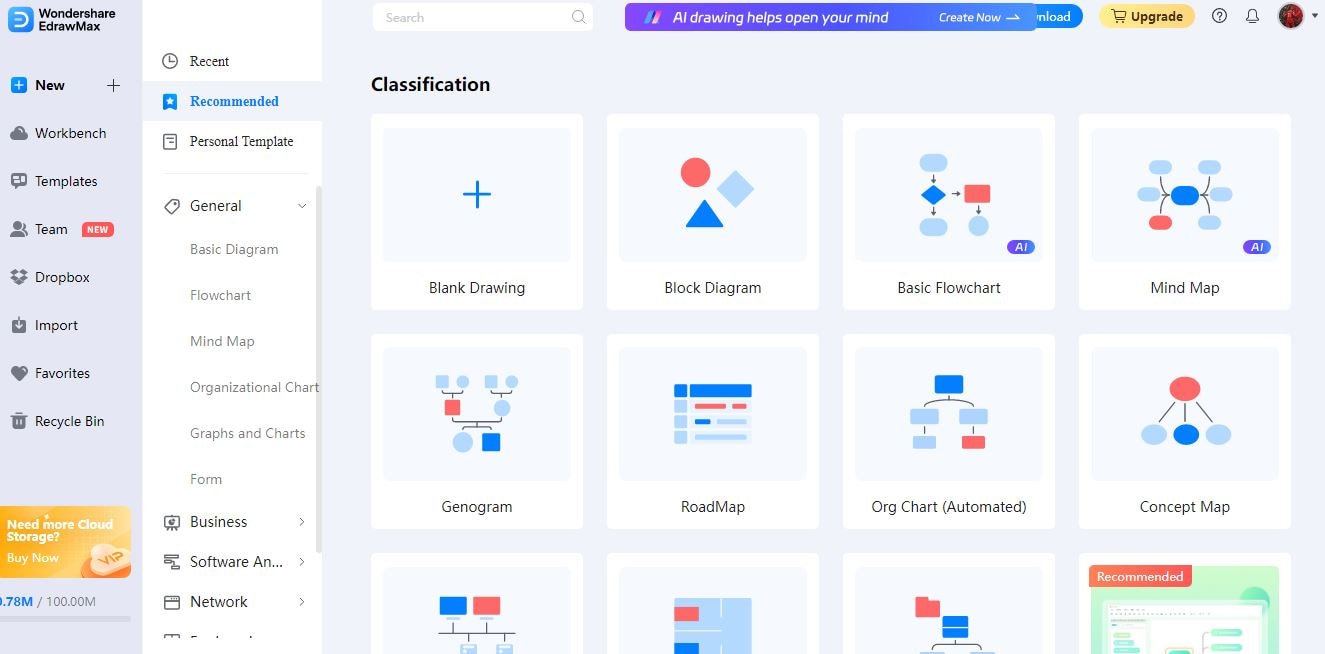
Step3Add Family Members
Add family members to your genogram by dragging and dropping symbols from the left-hand side of the screen onto the canvas.
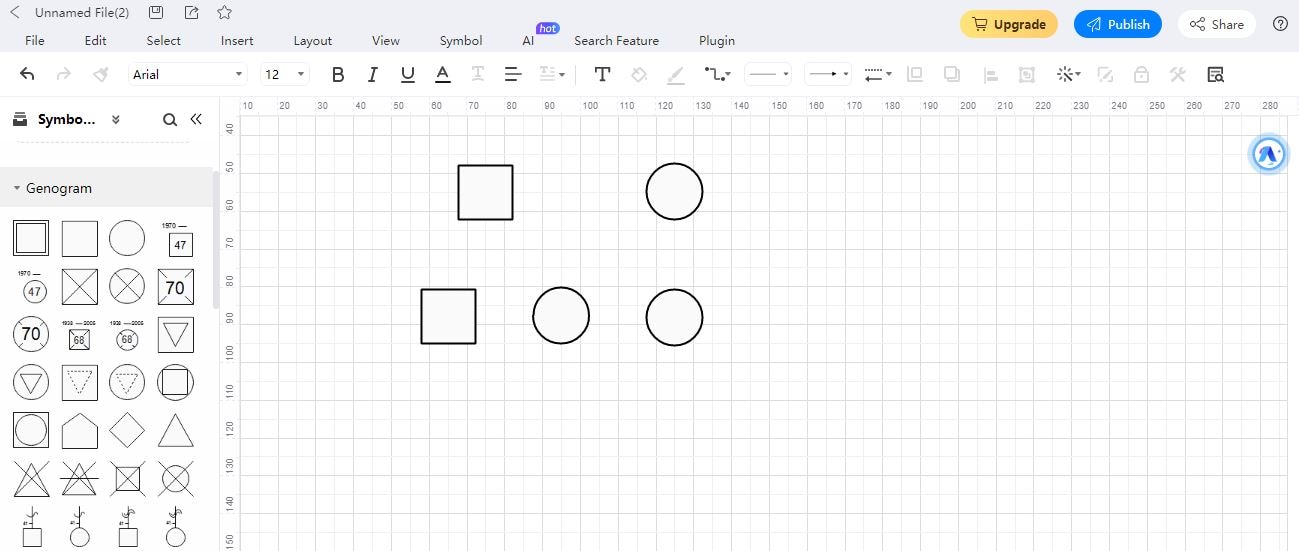
Step4Add Details
Add details about each family member, such as their name, date of birth, and occupation, by double-clicking on their symbol and entering the information in the pop-up window.
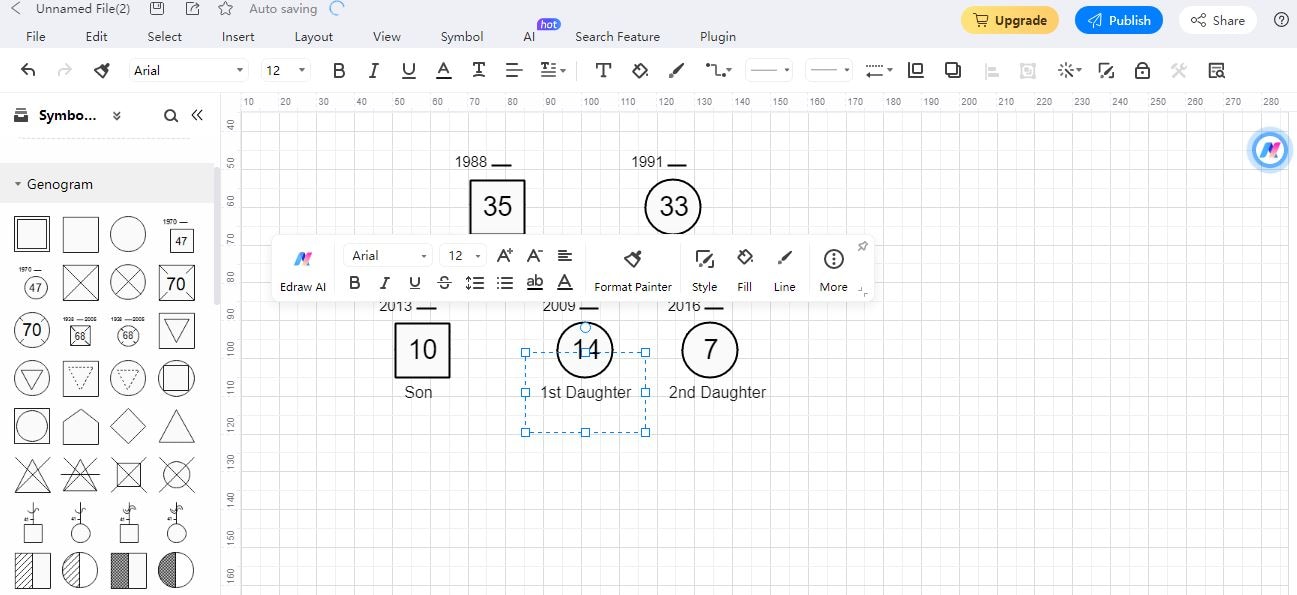
Step5Connect Family Members
Connect family members to each other using lines and arrows to indicate relationships such as marriages, parent-child relationships, and siblings.
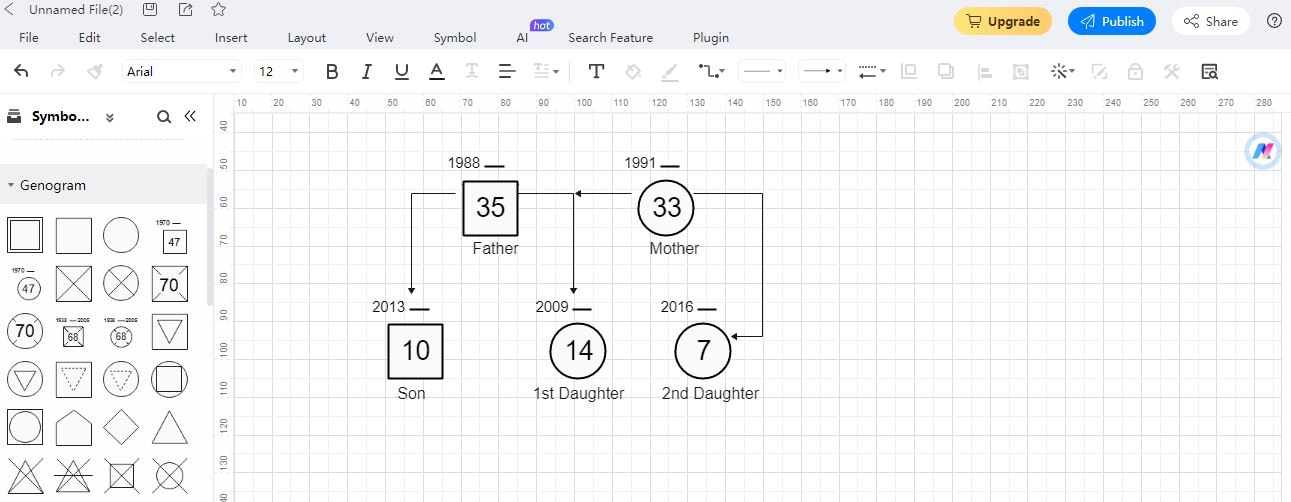
Step6Customize Your Genogram
Customize your genogram by changing colors, fonts, and other design elements to make it more visually appealing.
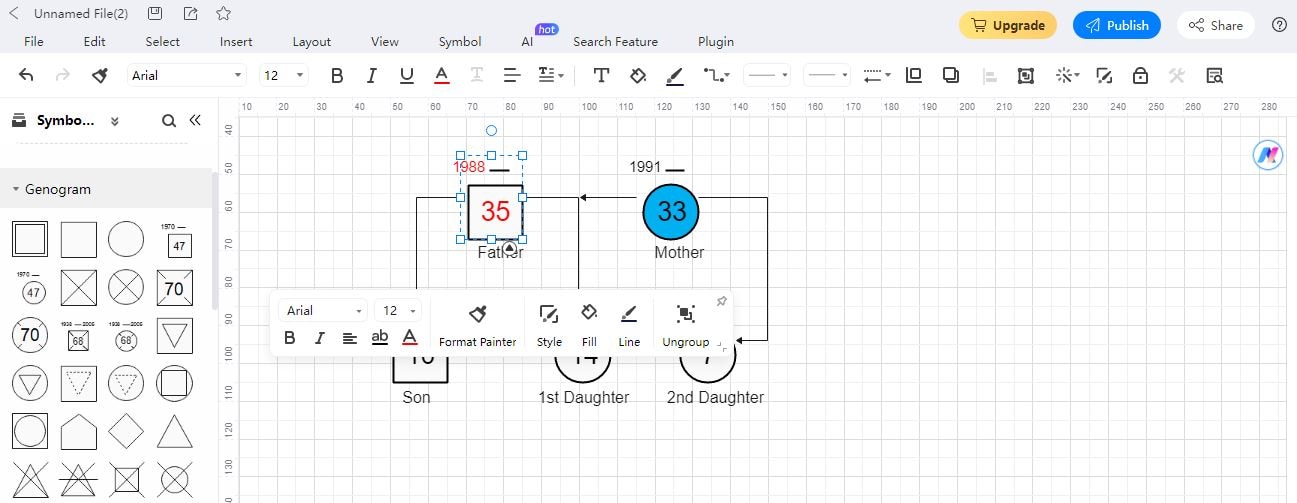
Step7Save and Export
Save your genogram to your computer or export it in a variety of formats such as PDF, PNG, or SVG.
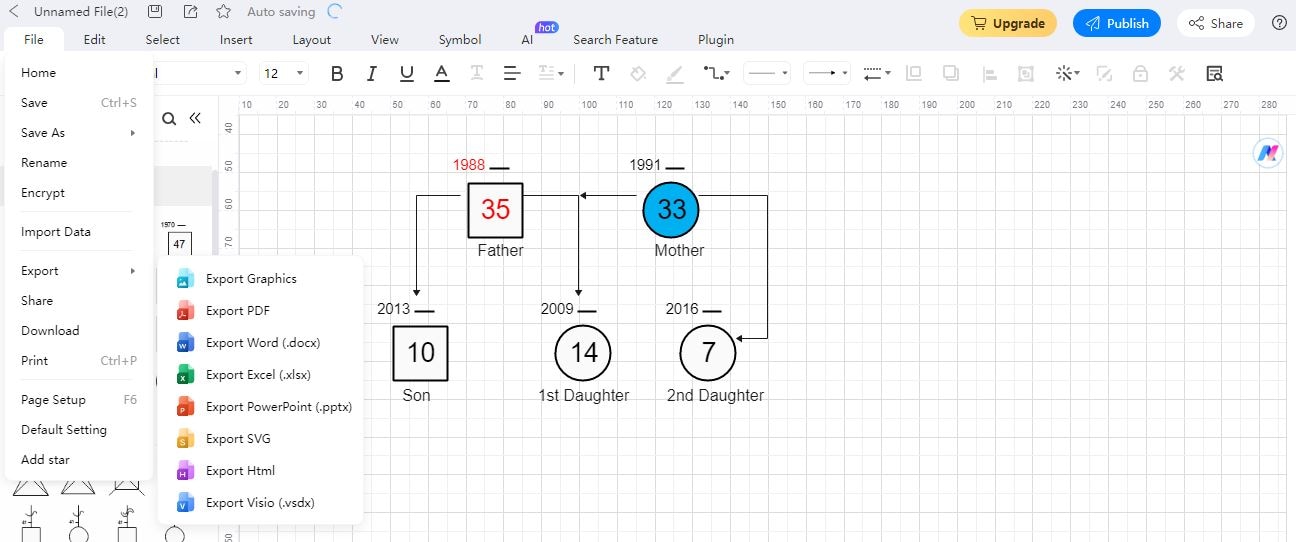
Part IV. Why Choose EdrawMax

EdrawMax is a user-friendly diagramming tool tool used for various purposes. EdrawMax offers a wide range of features that make it a great choice for individuals and teams. EdrawMax is available for Windows, Mac, and Linux. It is affordable and offers a free trial, so there is no risk in giving it a try.
EdrawMax has some key features that put it above its competitors.
Variety in Templates and Symbols
EdrawMax offers a high library of templates. It helps to create diagrams quickly and easily. This feature is helpful for new users of genograms or who need to create diagrams for specific purposes.
Formatting options
EdrawMax allows you to create a visually appealing and informative diagrams. You can customize diagrams with a variety of formatting options, including fonts, colors, and images.
Export options
EdrawMax enables users to export and share diagrams in many file formats, including PDF, PNG, and JPEG. These diagrams can also be shared via email.
Conclusion
Genograms are practical and fruitful tools for understanding family dynamics. They are used to map out a mental or physical health history and any medical history. We discussed ten examples of genograms related to family genograms, relationship genograms, career genograms, and financial genograms.
These examples are from templates community of EdrawMax. EdrawMax contains a vast collection of templates created by users worldwide. The examples are especially helpful for new users in creating diagrams. Genograms have the potential to impact various fields, such as family therapy, medicine, genetic research, education, and business.





 below.
below.  below.
below. 








